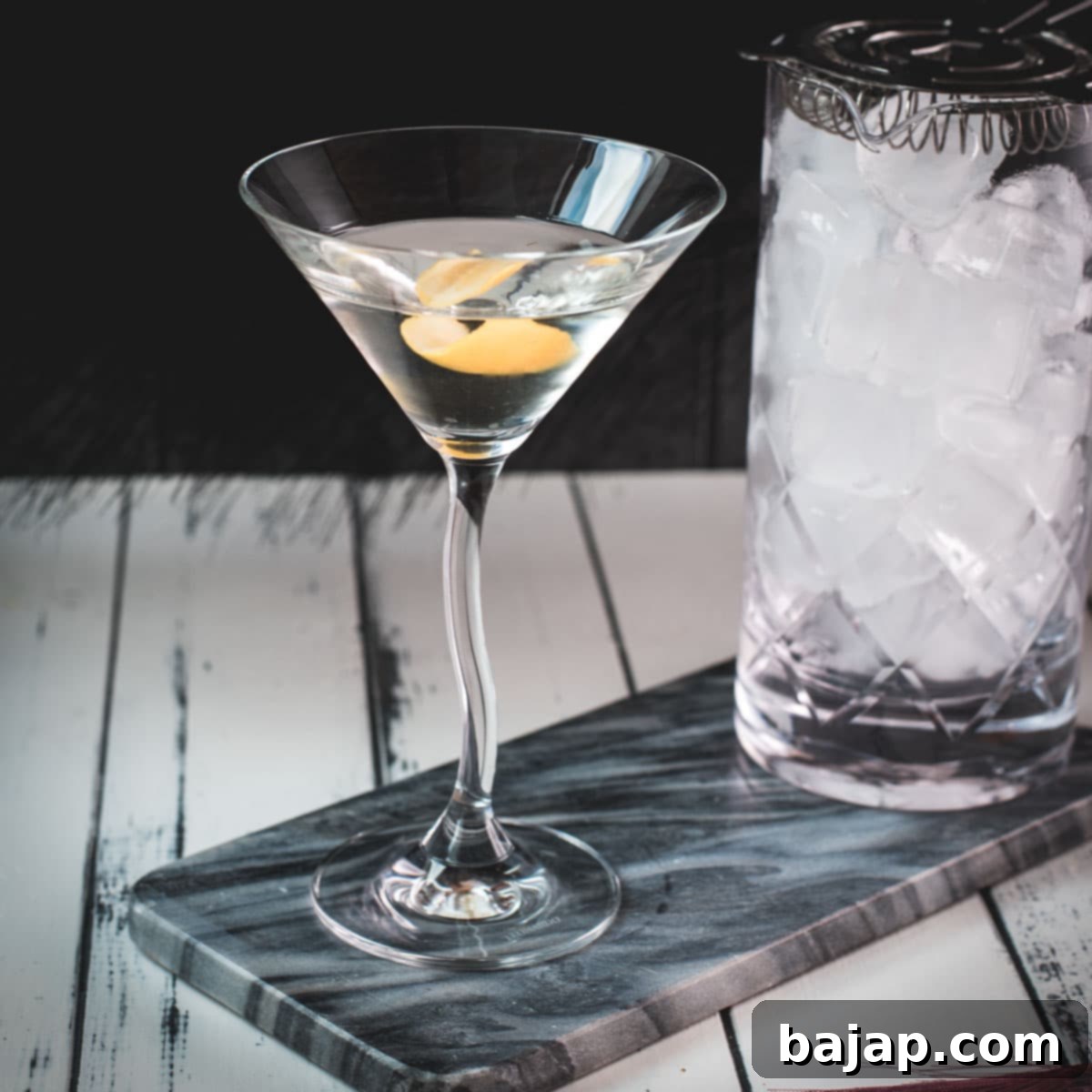The Ultimate Guide to Crafting the Perfect Martini: Classic Recipes & Expert Tips
Welcome, fellow cocktail enthusiast! As the year draws to a close, or perhaps as you simply seek to elevate an ordinary evening, there’s no better time to revisit a truly iconic libation: the classic martini. Timeless, undeniably elegant, and a symbol of refined sophistication, this legendary cocktail has graced countless gatherings, from intimate dinner parties to grand, glamorous galas. Its beauty lies in its deceptive simplicity – just a few core ingredients – yet it offers an endless spectrum of variations and personal preferences, making it an essential entry in every serious cocktail lover’s repertoire.
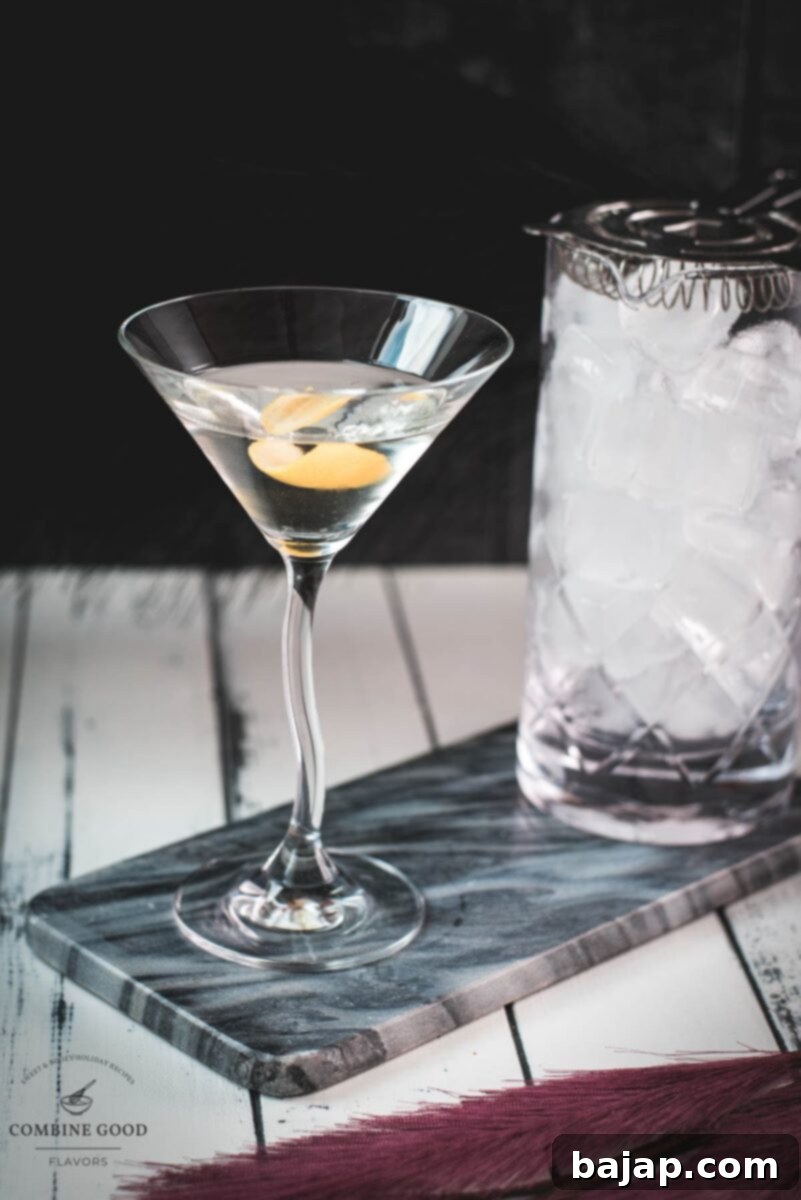
But what truly defines the “perfect” martini? Is it stirred to a crystal-clear sheen, or shaken to a frothy chill? And what about the subtle, yet significant, distinctions between a classic martini, a dry martini, or the ever-popular dirty martini? These questions are at the heart of martini mastery, and understanding them is key to crafting a drink that perfectly suits your palate and impresses your guests.
In this comprehensive guide, we won’t just share a single recipe; we’ll embark on a journey to demystify the martini. We’ll delve into the foundational techniques, explore the fascinating variations, and provide the insights you need to become a true martini aficionado. While many purists advocate for stirring in a mixing glass to achieve that desired velvety smooth texture and pristine clarity, other recipes, particularly those involving fruit juices or opaque ingredients, embrace shaking for a different kind of chilled aeration and mouthfeel. Rest assured, we’ll cover both the traditional methods and popular preferences.
So, let’s gather our tools and ingredients! Grab your preferred bottle of gin or vodka, a sturdy stirring glass (or a shaker if that’s your style), and most importantly, a pre-chilled martini glass. By the end of this article, you’ll possess not only the practical skills to mix a martini tailored precisely to your taste but also a deeper appreciation for its rich history and diverse expressions. Prepare to impress your guests, and yourself, with a touch of timeless elegance. Cheers to perfecting the art of the martini!
The Enduring Allure of the Martini: A Brief History
The martini’s origins are somewhat debated, shrouded in myths and competing claims, but its ascent to cocktail royalty is undeniable. Emerging in the late 19th century, possibly from a drink called the Martinez, the martini quickly evolved, solidifying its place as a symbol of sophisticated drinking. It found favor during the Prohibition era, often served clandestinely, and then exploded in popularity in the mid-20th century, thanks in no small part to its starring roles in popular culture – most famously, perhaps, as James Bond’s drink of choice. Bond’s “shaken, not stirred” preference, though contrary to traditional gin martini preparation, cemented the drink’s glamorous image in the public imagination.
From its elegant silhouette in a V-shaped glass to its powerful, clean taste, the martini embodies an era of glamour and continues to be a benchmark for bartenders and home mixologists alike. It’s more than just a drink; it’s a statement of style and a testament to the beauty of simplicity when executed flawlessly.
🎥 Video: How to Make a Classic Martini Cocktail
🥘 Essential Ingredients for Your Classic Martini
Crafting a superb martini begins with selecting high-quality ingredients. While the recipe is deceptively simple, each component plays a crucial role in the final flavor profile and overall experience. Skimping on quality here is a surefire way to miss out on true martini perfection.
- Cubed Ice: This isn’t just for chilling; it’s essential for controlled dilution. Always use fresh, clean, and ideally large cubes, as they melt slower and provide optimal chilling without over-diluting your precious spirits.
- Gin (or Vodka): The heart of your martini. For a true classic, gin is the traditional and preferred choice, offering a complex botanical backbone. Plymouth Gin, with its balanced, slightly sweeter, and citrusy profile, is an excellent top-tier option for a smooth, approachable classic martini. We’ll delve deeper into various gin and vodka options below to help you find your perfect match.
- Dry Vermouth: Often underestimated and sometimes even neglected, dry vermouth is absolutely vital. This aromatized, fortified wine adds herbaceous depth, a subtle bitterness, and rounds out the gin’s bold botanicals beautifully. Think of it as the gin’s sophisticated dance partner, essential for harmony.
- Garnish: The final flourish, adding both aromatic appeal and a hint of complementary flavor. A fresh lemon zest (or twist), expressed to release its fragrant oils, provides a bright, aromatic lift. Alternatively, one or three high-quality green olives (odd numbers are traditional for good luck and aesthetics) offer a savory, briny counterpoint, especially if you prefer a less aromatic finish.
For precise quantities and specific measurements for a single serving, refer to the detailed recipe card at the end of this post.
🔪 Step-by-Step Instructions: Crafting Your Classic Martini
Follow these steps carefully and thoughtfully to achieve a perfectly balanced and impeccably chilled classic martini every time. Remember, precision and attention to detail are paramount to mastering this elegant cocktail, transforming simple ingredients into liquid art.
Step 1: Chill Your Glassware and Combine Spirits
Before you even think about mixing, ensure your martini glass is thoroughly chilled. This can be achieved by placing it in the freezer for at least 15 minutes, or by filling it with ice water while you prepare the drink. A well-chilled serving glass is fundamental to preventing rapid dilution of your finished martini. Next, pour your chosen gin (or vodka) and dry vermouth into a separate, equally chilled mixing glass. The cold environment of the mixing glass helps maintain the martini’s crisp, smooth character by slowing down ice melt during the stirring process, which is crucial for perfect dilution.


Step 2: Add Ice and Master the Stirring Technique
Fill your mixing glass generously with fresh, cubed ice. This isn’t just to chill the drink; it’s also crucial for achieving the perfect amount of dilution, which mellows the spirits and enhances the flavor. Insert a long-handled bar spoon into the glass, ensuring it reaches the bottom. Stir the drink with a smooth, continuous, and gentle motion, gliding the back of the spoon along the inner rim of the glass. The goal is to create a controlled, rotating movement of the ice cubes rather than vigorous churning. Stir for approximately 20-30 seconds, or until the exterior of the mixing glass feels frosty to the touch and a thin layer of condensation forms. This technique ensures the drink is perfectly chilled, achieves a velvety smooth texture, and remains crystal clear without introducing unwanted air bubbles or cloudiness.


Step 3: Strain for Impeccable Silky Smoothness
Once thoroughly chilled, remove any ice water from your pre-chilled cocktail glass. Place a julep strainer (or a Hawthorne strainer with a tight spring) over the mixing glass to effectively hold back the ice. For an exceptionally silky-smooth martini that is free of even the tiniest ice shards or vermouth particles, we highly recommend an additional step: pour the cocktail through a fine mesh strainer directly into your chilled martini glass. This double-straining method ensures your martini is pristine, flawless, and presents with an elegant, clear appearance.
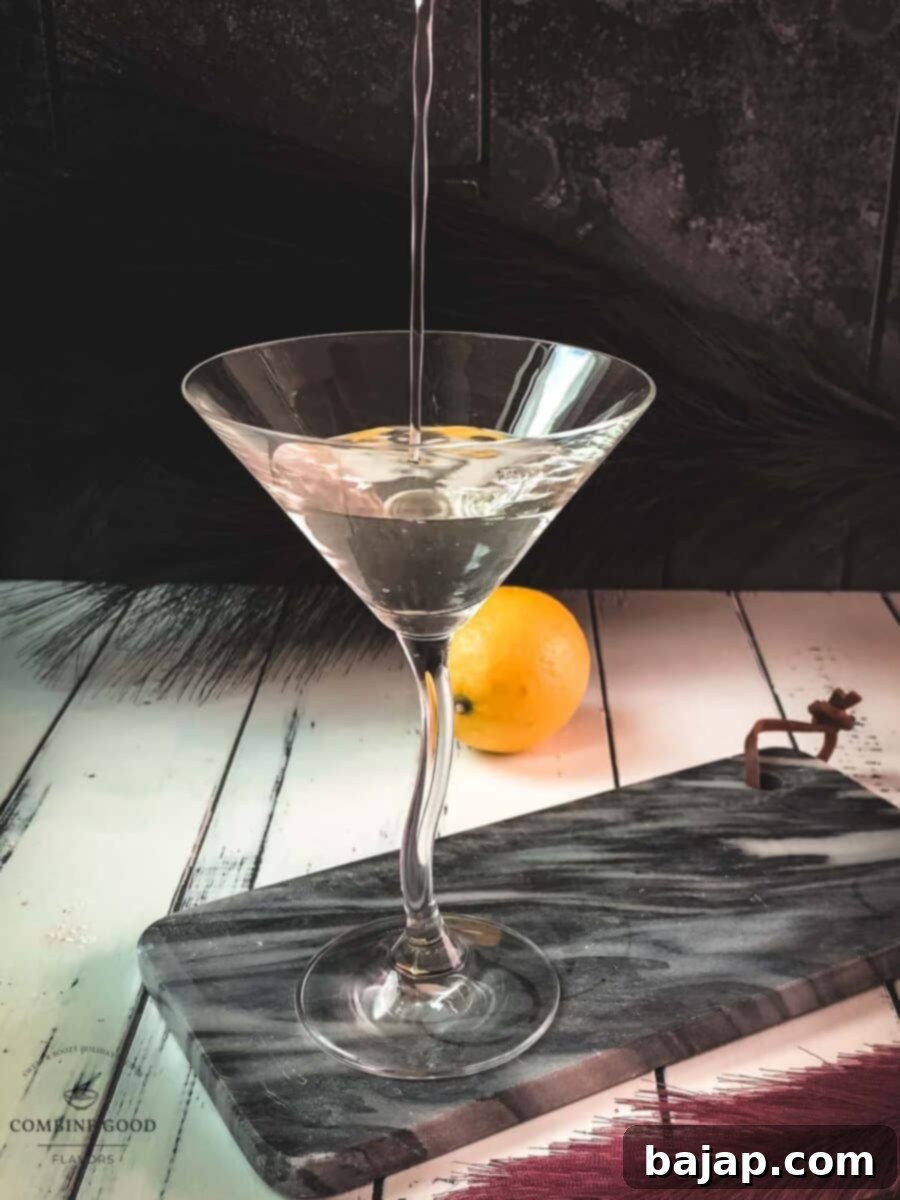
Step 4: Garnish and Serve Immediately with Flair
The final touch is where you truly personalize your masterpiece. For a classic gin martini, you have two excellent, time-honored choices. A twist of fresh lemon zest, carefully peeled and expressed over the drink to release its fragrant citrus oils, adds a bright, aromatic lift that awakens the senses. Alternatively, one or three high-quality green olives (speared on a cocktail pick for an elegant presentation) provide a savory, briny complement that many find irresistible. Serve your expertly crafted martini immediately to ensure it’s enjoyed at its optimal temperature and exquisite balance. Cheers to your perfect pour!
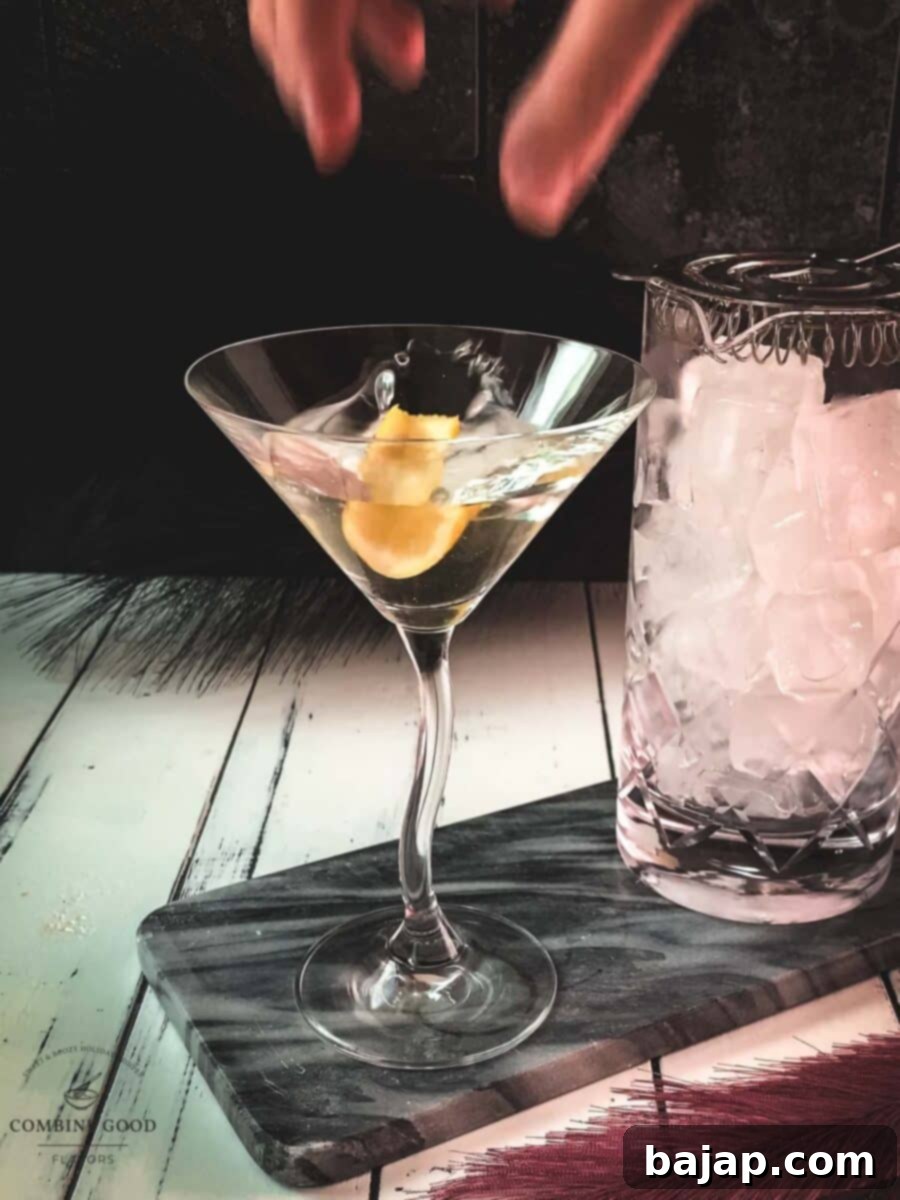
🍸 Mastering the Martini Variations: Classic, Dry, and Dirty
While the basic components of a martini remain surprisingly consistent, the subtle nuances of ratios and additional ingredients create vastly different flavor experiences. Understanding these popular variations is absolutely key to customizing your drink, ordering precisely what you desire at a bar, or impressing your friends with your cocktail knowledge. Let’s explore the distinct characteristics and appeal of the most popular martini styles.
1. The Classic Martini
This is the quintessential martini, the benchmark against which all others are measured – an elegant, timeless, and perfectly balanced cocktail that highlights the interplay between its few, high-quality ingredients. The classic martini combines gin (or vodka, if preferred) with dry vermouth, meticulously stirred over ice until perfectly chilled and crystal clear, creating a smooth and harmonious sip.
- The Ratio: Traditionally, a 2:1 or 3:1 ratio of gin to vermouth is used. This allows the vermouth to truly shine alongside the gin, offering a more nuanced and aromatic profile. Some traditionalists even venture to 4:1 or 5:1 for a slightly drier, yet still balanced, taste.
- The Garnish: A carefully expressed lemon twist to add bright, aromatic citrus oils that complement the gin’s botanicals, or one to three high-quality green olives for a subtle savory counterpoint that many find irresistible.
- The Flavor Profile: A harmonious and sophisticated blend. The gin’s complex botanicals (juniper, citrus, herbs, spices) are beautifully complemented and softened by the gentle herbal sweetness and subtle bitterness of the vermouth. The result is smooth, crisp, refreshing, and incredibly sophisticated, offering a delightful aromatic complexity.
- Why You’ll Love It: It’s the ultimate expression of cocktail craftsmanship – versatile, always in style, and a true testament to the quality and balance of its core spirits. It’s perfect for those who appreciate the delicate interplay of distinct flavors rather than a spirit-forward punch alone.
2. The Dry Martini
For those who prefer their gin to truly sing and take center stage, the dry martini significantly reduces the vermouth, allowing the gin’s bold botanical character to dominate the palate. This style is for the purist who appreciates the raw, unadulterated spirit with just a whisper of aromatic complexity.
- The Ratio: This can range from a very dry 5:1 or 6:1 gin to vermouth, all the way to a “Naked Martini” or “Montgomery” (named after a British Field Marshal who preferred a 15:1 ratio), where vermouth is merely a whispered presence – a quick glass rinse, a brief spray from an atomizer, or even, as famously quipped, “just a glance at the vermouth bottle from across the room.”
- The Garnish: A crisp lemon twist is often favored to highlight the gin’s inherent citrus notes, enhancing its brightness. A simple green olive is also acceptable if preferred, but usually chosen for its texture rather than its briny flavor contribution.
- The Flavor Profile: Sharper, cleaner, and undeniably gin-forward. The vermouth acts more as a subtle enhancer or a ghost of an aroma rather than a co-star, offering just a hint of herbal complexity without adding any perceptible sweetness. The predominant flavor is that of the chosen gin.
- Why You’ll Love It: It’s a direct, uncompromising, and no-nonsense approach to cocktail sophistication, celebrating the intricate and robust flavors of your chosen gin above all else. A truly dry martini is potent, invigorating, and a powerful statement.
3. The Dirty Martini
If you crave a savory, briny kick and a cocktail with a bold, umami-rich character, the dirty martini is your ultimate indulgence. This popular variation introduces a splash of olive brine to the mix, transforming the classic cocktail into a deliciously salty and highly addictive experience that appeals strongly to olive lovers.
- The Ratio: The gin-to-vermouth ratio is typically similar to a classic martini (e.g., 3:1 or 4:1 gin to vermouth), but the crucial addition is ½ to 1 ounce of good quality olive brine, depending on your desired level of “dirtiness” and saltiness. Start with ½ ounce and adjust to taste.
- The Garnish: Absolutely, unequivocally, olives! The more, the merrier, often three on a cocktail pick. For an extra luxurious and flavorful touch, consider using blue cheese-stuffed olives, which add another layer of savory richness.
- The Flavor Profile: Boldly savory, wonderfully briny, and distinctly umami. The saltiness from the olive brine creates a fantastic counterpoint to the gin and vermouth, adding a rich, mouth-filling depth that is incredibly satisfying and distinctive. It’s a full-bodied, robust experience.
- Why You’ll Love It: It’s a cocktail that delightfully doubles as a savory snack, offering a delightful tang and a satisfyingly salty punch that martini and olive lovers find utterly irresistible. It’s a flavor adventure for those who appreciate a bolder, more assertive palate in their drinks.
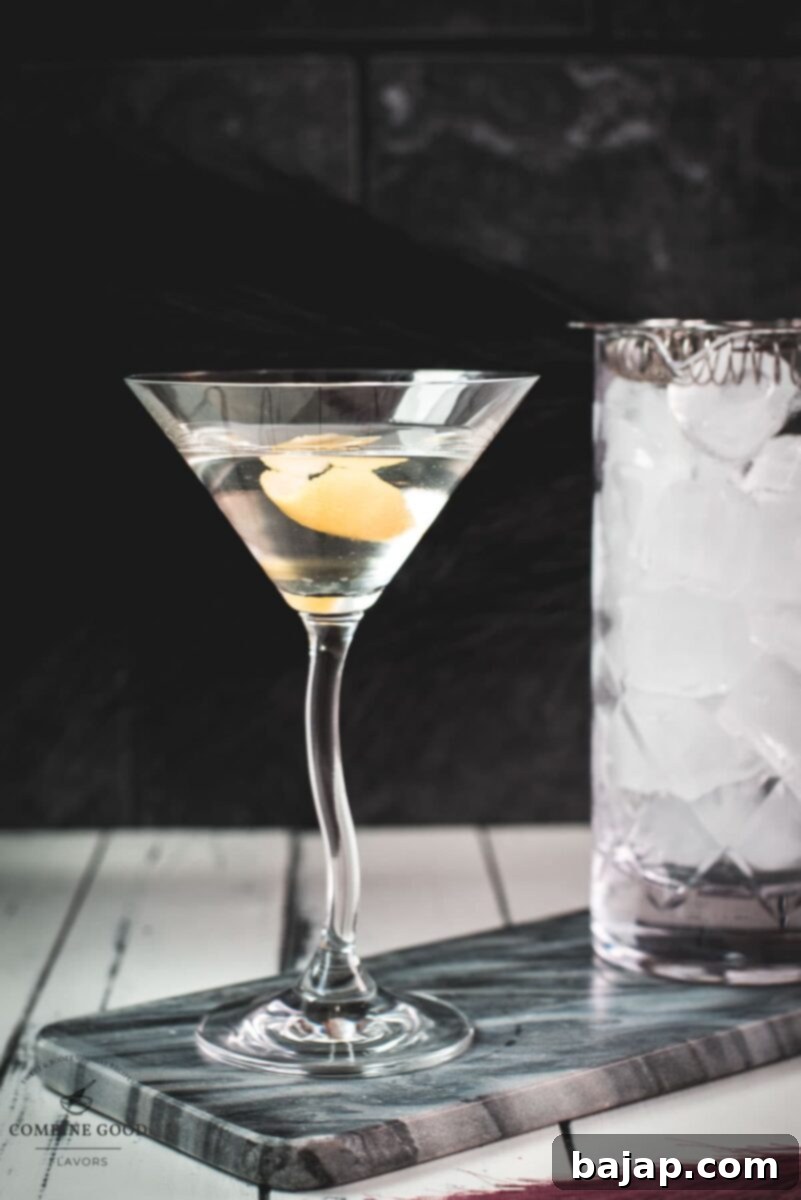
Choosing Your Spirits: Gin, Vodka & Dry Vermouth Explained
The quality and character of your chosen spirits are absolutely paramount to crafting a stellar martini. A deep understanding of your gin, vodka, and vermouth will empower you to create a truly personalized and consistently delicious cocktail that reflects your individual taste.
Selecting Your Gin: The Soul of a Classic Martini
For a truly traditional martini, gin is the undisputed champion. Its complex botanical blend provides an aromatic and flavorful base that varies significantly between brands and styles. Different styles of gin offer distinct experiences, allowing for immense customization:
- Plymouth Gin: As previously highlighted, Plymouth Gin is a revered classic, celebrated for its smooth, balanced profile with pronounced earthy and citrusy notes. It’s typically less juniper-forward than many London Dry gins, making it exceptionally versatile and a consistently excellent choice for any martini aficionado, particularly those who prefer a softer, more harmonious gin presence.
- London Dry Gin: This is arguably the most common and popular style. Brands like Beefeater, Tanqueray (including the refined Tanqueray No. Ten), and Bombay Sapphire offer a crisp, juniper-dominant flavor profile that forms the backbone of many classic martinis. These gins create a more bracing, traditional, and aromatic martini experience. Tanqueray No. Ten, with its bright grapefruit and fresh lime notes, is particularly well-regarded for its ability to pair beautifully with a range of vermouths, creating a refreshing and vibrant twist on the classic.
- Old Tom Gin: A slightly sweeter style of gin that historically bridges the gap between the older Genever and modern London Dry. It’s an excellent choice for a slightly softer, rounder, and more “vintage” martini, especially if you prefer a less biting or dry finish.
- Modern & New Western Gins: Many craft distilleries are now producing gins with unique botanical blends, offering everything from intensely floral to spicy, savory, or even herbaceous notes. Experimenting with these can lead to exciting, highly personalized martinis, but be aware that they might depart significantly from the “classic” profile. It’s a great adventure for experienced palates!
The Vodka Martini: A Modern & Clean Alternative
While gin is traditional, the vodka martini soared in popularity in the latter half of the 20th century and remains a beloved choice for many. For a vodka martini, the focus shifts to the purity and smoothness of the spirit. Since vodka has a more neutral flavor profile compared to gin, selecting a smooth, high-quality vodka is paramount. This allows the subtle nuances of the vermouth and the chosen garnish to truly shine. Brands like Grey Goose, Belvedere, Ketel One, or even a crisp local craft vodka can create a clean, modern, and incredibly smooth take on the martini.
The Importance of Dry Vermouth: The Martini’s Secret Weapon
Vermouth, a fortified, aromatized wine, is often misunderstood but is an indispensable component of a great martini. Its freshness is absolutely crucial – treat it like a delicate wine, not a shelf-stable spirit. Always store opened vermouth in the refrigerator and ideally use it within 2-3 months to prevent oxidation, which can lead to a flat or off-tasting martini. Your choice of dry vermouth can dramatically impact your martini’s complexity and balance:
- Lighter & Crisp Vermouths: Brands like Dolin Dry from France are celebrated for their crisp, delicate, and subtly floral profiles. These vermouths are ideal when you want the gin or vodka to remain the star, adding a gentle whisper of complexity without overwhelming the base spirit.
- More Robust & Herbaceous Vermouths: Options like Carpano Dry from Italy offer a bolder, richer, and often more herbaceous flavor. These can add significant depth and character to your martini, standing up well to more assertive or juniper-heavy gins.
- For Dirty Martinis: A vermouth like Noilly Prat Original Dry, with its slightly briny and nutty notes, can beautifully complement the olive brine, further enhancing the savory and umami experience of a dirty martini. Its distinct character melds seamlessly with the salty kick.
Experimentation is genuinely key to discovering your ultimate martini. Try different combinations of gin (or vodka) and vermouth to discover your perfect pairing. From a classic gin-and-lemon-twist to an adventurous thyme-garnished signature cocktail, the possibilities for customization are truly endless. Don’t be afraid to mix and match until you find the balance that sings to your palate.
🍽 Essential Bar Equipment for Your Martini Masterpiece
Having the right tools at your disposal makes all the difference in crafting a professional-quality martini in the comfort of your own home. These essential bar tools are designed to ensure precision, optimal chilling, and a flawless presentation. Here’s what you’ll need and why each piece is important:
- Measuring tools / Jigger: Absolutely essential for precise measurements and consistent ratios of your spirits and vermouth. Accuracy ensures balance in every drink you make.
- Stirring Glass: A heavy-bottomed, thick-walled glass specifically designed for chilling and diluting spirits-only cocktails without aeration. This results in the martini’s signature crystal-clear appearance.
- Bar Spoon: A long, often twisted spoon that is perfect for smooth, controlled stirring in a tall mixing glass, as well as for layering ingredients or adding garnishes.
- Julep Strainer: A classic strainer, shaped like a perforated spoon, designed to fit snugly over a stirring glass. It allows the liquid to pass through while effectively holding back ice and other larger solids.
- Fine Strainer: An additional, fine-mesh strainer used for “double-straining.” This crucial step catches any tiny ice shards, citrus pulp, or botanical fragments, ensuring a perfectly smooth, pristine, and elegant cocktail.
- Cocktail Glass: Typically a classic V-shaped martini glass or a more rounded coupe glass. Always ensure it’s thoroughly pre-chilled to keep your drink colder for longer, minimizing unwanted dilution.
- Sharp Knife & Cutting Board: Indispensable for safely and precisely preparing citrus twists, lemon zests, and other garnishes that add the final touch to your martini.

💭 Top Tips for Martini Perfection
Achieving martini perfection is an art, but these expert tips will guide you to a consistently exceptional drink:
- Master the Stirring Technique for Clarity: The primary goal of stirring your martini (especially gin or vodka-based ones) is to chill and slightly dilute it without introducing air, which would result in a cloudy drink. When stirring in your mixing glass, use a bar spoon and slide it smoothly along the inner side of the glass. This creates a gentle, continuous, and efficient rotation of the ice cubes, ensuring even chilling and optimal dilution. Stir for about 20-30 seconds, or until the exterior of your mixing glass is visibly frosted and ice cold. The aim is a silky, balanced, and crystal-clear martini every single time.
- Strain Like a Pro (Double Strain for Purity): For the ultimate smooth finish and an aesthetically perfect martini, employ a double-straining method. First, place a julep strainer (or a Hawthorne strainer) over your mixing glass to hold back the larger ice cubes. Then, as you pour, pass the liquid through a fine mesh strainer directly into your pre-chilled cocktail glass. This extra step captures any tiny ice shards, citrus pith, or botanical fragments, ensuring your martini is pristine, flawless, and elegantly clear.
- Chill Everything, Always: This tip cannot be stressed enough! Spirits, vermouth (especially once opened), your mixing glass, and most critically, your serving glass should all be thoroughly chilled before you begin mixing. The colder your components, the less your ice will melt during stirring, leading to less unwanted dilution and a colder, more potent, and more flavorful martini.
- Fresh, Quality Ice is a Must: Always use fresh, clean ice cubes made from potable water for mixing. Old ice can absorb unpleasant freezer odors, which can easily transfer to your delicate martini. Large, dense ice cubes also dilute slower, giving you greater control over the final strength and temperature of your cocktail.
- Treat Vermouth Like Wine: Remember that vermouth is an aromatized, fortified wine. Once opened, it begins to oxidize and degrade in flavor, just like regular wine. To maintain its nuanced flavor profile, always store opened vermouth in the refrigerator and ideally aim to use it within 2-3 months. Oxidized vermouth can make your martini taste flat, stale, or simply “off.”
Explore More Martini Recipes and Variations
The delightful world of martinis extends far beyond the classic gin and vodka iterations. Once you’ve mastered the fundamentals of the classic, dry, and dirty styles, feel free to expand your horizons and experiment with these exciting variations and related cocktails. Each offers a unique twist on the beloved original:
- Cranberry Peppermint Martini: A festive and refreshing twist, perfect for holiday gatherings.
- Watermelon Martini: A sweet, fruity, and incredibly refreshing option for warmer days.
- National Martini Day {roundup}: A collection of diverse martini ideas to celebrate this iconic drink.
- Limoncello Martini with Elderflower Syrup: A vibrant, sweet-tart martini with floral notes for a sophisticated dessert cocktail.
- Raspberry Lemon Drop Martini Recipe: A tangy and sweet martini bursting with berry and citrus flavors.
- Limoncello Martini with Lemon Juice {shaken}: A zesty and invigorating martini, shaken for a slightly frothy texture.
- How to Make a Martinez Cocktail: Explore the historical precursor to the modern martini, a rich and complex drink in its own right.
We sincerely hope this comprehensive guide empowers you to confidently craft your ideal martini, whether you prefer it classic, dry, or satisfyingly dirty. The enduring beauty of this timeless cocktail lies in its adaptability and the personal touch you bring to each creation. Experiment with different gins and vermouths, adjust ratios to your liking, refine your techniques, and most importantly, savor the timeless elegance and sophisticated pleasure in every single sip! May your martini endeavors always be perfectly chilled and exquisitely balanced.
If you try this classic martini recipe or any of its variations, we would absolutely love to hear from you! Please let us know how you liked it by giving it a ★★★★★ star rating and leaving a comment below. Your valuable feedback helps us grow and inspires other cocktail enthusiasts to embark on their own martini-making journey! You can also sign up for our Newsletter to receive delicious homemade recipes weekly, or follow us on Pinterest or Instagram. Don’t forget to share your creation with us by tagging @combinegoodflavors and using the hashtag #combinegoodflavors – we can’t wait to see your stunning martini masterpieces!
📖 Recipe: Master the Classic Martini

Master the Classic Martini
Nora
Save RecipeSaved!
Pin Recipe
Equipment
-
Measuring tools / Jigger
-
Stirring glass
-
Bar spoon
-
Julep strainer
-
Fine-strainer
-
Cocktail Glass
-
Sharp knife & cutting board
Ingredients
- 1 ¾ oz Gin Plymouth Gin is a top-tier option
- ½ oz Dry Vermouth
- Cubed ice for the stirring glass
- Lemon zest or Olive for garnish
Instructions
